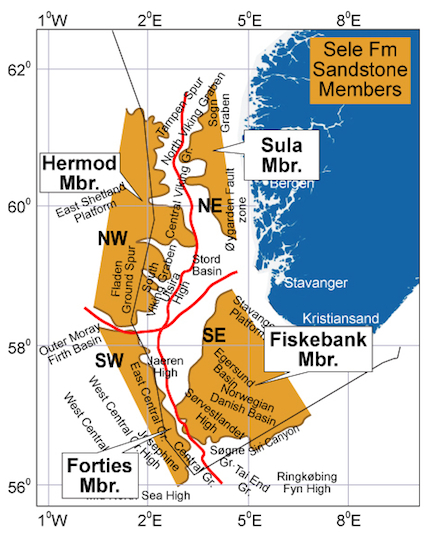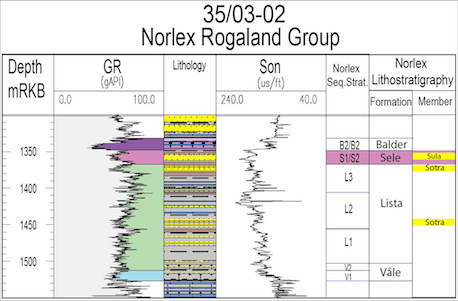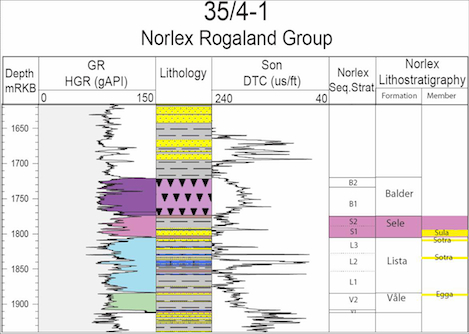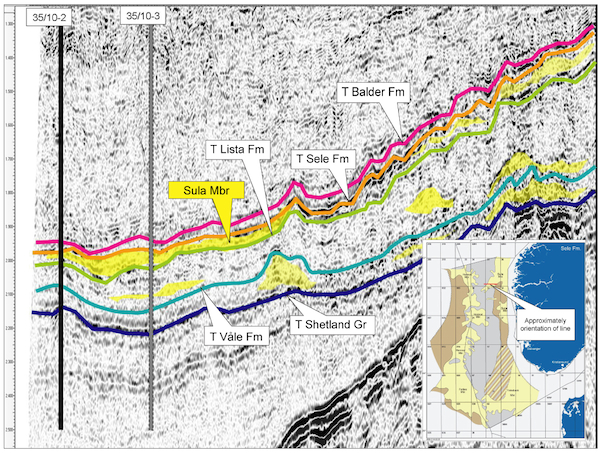Sula Member (new)
updated to follow: Stratigraphic Guide to the Rogaland Group, Norwegian North Sea. Harald Brunstad, Felix M. Gradstein, Jan Erik Lie, Øyvind Hammer, Dirk Munsterman, Gabi Ogg, and Michelle Hollerbach. Newsletter on Stratigraphy, vol 46/2 pp137-286, 2013.
Rogaland Group, Sele Formation
Unit definition
Sula Member is attributed to the Intra Sele Formation sandstones in Subarea NE in
Fig. 1.
 Fig 1: Location map of the Members of the Sele Formation.
Fig 1: Location map of the Members of the Sele Formation. |
Name
The Sula Member is defined for first time in this study. The Sula Member is
attributed to intra Sele Formation sandstones in the northeastern parts of the North
Sea Basin.
Derivatio nominis
The Sula Member is named after one of the largest islands in Hordaland.
Type well
Norwegian well 35/3-2 (new, Fig. 122). Depth 1355-1363 mRKB. Coordinates N61°51'05.98", E 03°46'28.22".
No cores.

Fig. 122. Well 35/3-2 Composite log Rogaland Group. Stratigraphic position of the
Sula Member is outlined in stratigraphic column to the right.
|
Reference wells
Norwegian well 35/4-1 (new, Fig. 123). Depth 1795-1803 mRKB. Coordinates N 61°32'00.55", E 03°18'00.26". No
cores.
Norwegian Well 35/10-3 (new). Depth 1948-1985 mRKB. Coordinates N 61°02'47.96", E 03°07'40.70". No cores.

Fig. 123. Well 35/4-1 Composite log Rogaland Group. Stratigraphic position of the
Sula Member is outlined in stratigraphic column to the right.
|
Composition
The Sula Member consists of friable quartzitic sandstones, clear to white, yellow to
green, fine to coarse grained, but mostly medium sized with subrounded to
subangular grains. The sandstones are mostly non calcareous with occasional interbeds
of grey claystone, and slightly silty. Poorly to well sorted, sub rounded to sub
angular, often well sorted. Traces of mica, glauconite and shell debris are common.
Non-calcareous.
No cores exist in the Sula Member, and limited information on facies variability is
available.
Wireline log characterization
The wireline log response of the Sula Member is blocky to serrated, variably
representing thick clean sandstones and series of thinner sandstone layers in
alternation with mudstones. Sometimes high velocities and density values are seen,
corresponding to zones of calcite cementation in the sandstones.
Upper boundary
The Sula Member is overlain by the shales of the Sele or Balder Formation. When the
Sele Formation lies on top, the boundary is generally seen as an upwards increase in
gamma-ray response and a decrease in velocity.
Where the Balder Formation directly overlies the Sula Member, the boundary may be
seen as an upwards decrease in gamma-ray response and an increase in velocity from the
Sele and Lista formations.
Lower boundary
The basal contact of the Sula Member is seen as the boundary between shales of the
Sele or Lista Formation below and the
coarser sediments of the Sula Member above,
but this boundary is often not well defined. The boundary is placed where there is an
upwards transition from higher gamma-ray readings and higher velocity.
Thickness
In wells the Sula sandstones are usually found as series of thin, serrated
sandstones with thicknesses of only a few meters. A 37 m thick blocky Sula sandstone
is found in well 35/10-3. From seismic there is evidence of thicker development
elsewhere.
Seismic characterization
The sandstones belonging to the Sula Member sometimes occur within westward dipping
seismic reflectors inside the overall westward thinning wedges (prograding slope) of
the Rogaland Group from the Måløy Terrace/Horda Platform into the Sogn Graben.
In some cases the presence of blocky log response in wells corresponds to mounded
geometries or channel like lenses, especially in the lower and distal parts of the
prograding wedge.
Fig. 124 shows a seismic line through well 35/10-2 where thin stringers of Sula
Member sandstones are found, and the well 35/10-3, where a blocky Sula Member
sandstone of 37 m thickness is present.

Fig. 124. Seismic section from Sogn Graben to Horda Platform running through 35/10-2
and close to 35/10-3. Inferred presence of Sula Member is highlighted.
|
Age
Latest Paleocene-Earliest Eocene (Late Thanetian and Earliest Ypresian).
Biostratigraphy
The Sula Member is stratigraphically contained within the Sele Formation, and its
biostratigraphic age is thus limited by the same biostratigraphic events that bounds
the Sele Formation.
Correlation and subdivision
The Sula Member is stratigraphically divided into Sula S1 and Sula S2
corresponding to Sele 1 and Sele 2 and separated by a high gamma peak. However, the
recognition of
the boundary between the two sub-units is often difficult in this area because there
is generally a less diagnostic development of the high gamma-ray peaks within the Sele
formation in this area compared to further south.
Geographic distribution
The Sula Member is present from the area south of Selje High, stretching south to
the Horda Platform, and westwards into the Sogn Graben (Fig. 102). It is
not known whether the Sula Member is stretching southwards into the Stord Basin
Graben due to lack of well control in that area.
Depositional environment
The sandstones of the Sula Member were deposited from sand transported by submarine
gravity flow systems. In the eastern areas the Sula Member was largely deposited as
proximal turbidites in proximal parts of submarine slope fans on a prograding slope.
Further west in the Sogn Graben, the sands were deposited in a basin floor fan
setting.
Discoveries with the Sula Member as reservoir
No commercial discovery has been made in the Sula Member.


 Fig 1: Location map of the Members of the Sele Formation.
Fig 1: Location map of the Members of the Sele Formation.

